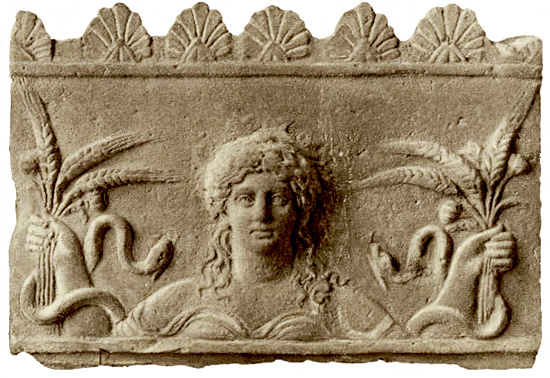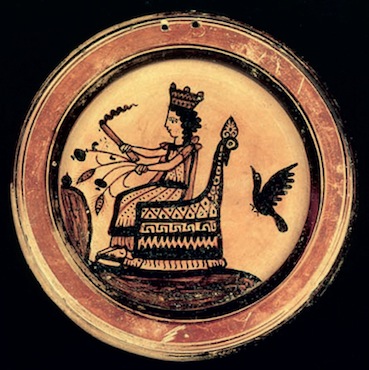The Mysteries of Demeter and the heady drink
Since the dawn of time, man has tried to get in touch with the gods, perceived as superior intelligence, through the modified states of consciousness, both with the help of...
Since the dawn of time, man has tried to get in touch with the gods, perceived as superior intelligence, through the modified states of consciousness, both with the help of...
To talk about Florentine festivals, with particular reference to the Renaissance, means to look in-depth at the very fabric of the “City of the lily”, in all its sides...
We cannot affirm that human’s taste has always been constant over the centuries and millennia. We remain astonished at how our tastes differ from our ancestors every time we read...
The wine in a Greek inscription from the 8th century B.C. Since ancient times, oil and wine have been very important elements in the diet of the Greek and Italian populations. It...
Time machine does not always proceed backwards towards extraordinary and memorable days. Actually, 1 December 1928 appears as an ordinary working day. Yet, behind the crumpled and...
Foreword by Giovanna Frosini Materials, shapes, colours, flavours: the language of food transforms all this into words, it coats with sounds a fundamental and daily experience,...
Leonardo da Vinci: a genius in the kitchen We have used to it. After Dan Brown’s and Marco Malvaldi’s Leonardo, we are all somehow “from Vinci”, especially in this...
Since the dawn of time, man has tried to get in touch with the gods, perceived as superior intelligence, through the modified states of consciousness, both with the help of psychotropic substances, sacred drinks and through exercises and coded rituals.
Ritual ceremonies aimed at these purposes were in use in ancient Greece already in the archaic period and, perhaps, even in the Mycenaean age (1500-1100 B.C.). I refer to an extremely interesting aspect of the Greek religion: the so-called sacred mysteries, which are still today the subject of historians’ investigation and discussion.
The Mysteries were reserved for priests and only the “mystai”, namely, the followers.
There were different types of Mysteries: Eleusinian (in Attica) reserved for the goddess Demeter, Dionysian (Bacchus), Orphic, etc.
In the Hellenistic age, the number of mystery cults increased as secret rituals dedicated to Isis and Osiris, Mithras, Cybele and Attis and other gods.
In this article, we will deal with a particular aspect of the cult of Demeter and Persephone celebrated at Eleusis.
A very ancient poetic text, the Hymn to Demeter, attributed to Homer, but dating back to the VII century, narrates the dramatic kidnapping of Persephone, daughter of Demeter and Zeus, by the god of the Underworld Hades, who wanted to marry her against the will of the goddess’ mother.

However, Demeter did not surrender to the disappearance of her daughter. She anxiously looked for her until they informed her about what had happened.
During Persephone’s search, the only refreshment for the goddess, on an empty stomach, would have been a drink, the kykeon, described in the Hymn, Vv. 200 ff.: “Then Metaneira filled a cup with sweet wine and offered it to her; but she refused it, for she said it was not lawful for her to drink red wine, but bade them mix meal and water with soft mint and give her to drink. And Metaneira mixed the draught (kykeon) and gave it to the goddess as she bade.”
This is not the first mention of the drink in Greek literature: Homer recalls it in the Iliad (XI, 624 ff) and the Odyssey (X, 234 ff.). Here the poet says that Circe offered kykeon (wine with dried milk, flour and honey) to Ulysses’ companions. The drink mixed with poisonous substances (farmaka), turned men into pigs. Evidently, in a very archaic phase, people attributed extraordinary powers to kykeon, correctly employed.
In the Augustan age, many centuries later, even the Latin poet Ovid, in his Fasti (IV, 531-2), recalled the theme of the drink Demeter sipped and, in describing the mixture, while not mentioning its name, he indicated that its ingredients were wine added with toasted rye flakes.
From the facts reported it is clear that since the added substances were not able to dissolve in the liquid, it was necessary that the adepts, while drinking, repeatedly stirred the potion until they consumed it.
We should note that the name kykeon, which in Greek means “compound drink” or “mixed drink” – today we would say cocktail – clearly indicates the need for mixing the mixture.
Many scholars, ethnobotanists, anthropologists, ethnologists, chemists, toxicologists, psychopharmacologists, as well as classicists have believed that the kykeon caused the ecstatic states the initiates of Eleusis achieved. Horned rye (ergot) or other ingredients, such as barley flour, hallucinogenic mushrooms, or even poppy seeds, if not downright opium – known for some time in Crete – would have developed psychoactive effects.

The debate among scholars on the components of the drink is still open and, in the absence of greater archaeological documentation, it is far from finding a solution. For further information, see G. Samorini, “The use of psychoactive substances in the Eleusinian Mysteries”, 2008 (in Italian).
We should recognize that it will be difficult to solve this mystery, since only priests belonging to two noble Athenian families (ghene, in Latin gentes), the Eumolpids and Cerics, could make the kykeon, and that the substances related to the Mysteries are still unknown.
I believe that since the Mysteries of Demeter and Persephone were closely connected with the seasonal cycles, with agriculture and the fields, and being the goddess’ symbols the ear of corn, the narcissus and the poppy, we should limit our hypotheses to substances derived from these products.
In conclusion, I would like to report a well-known scholar’s statement, Giulia Sfameni Gasparro, who, in an essay on the mysteries of Demeter, in this regard wrote that the possible role of the hallucinogen “…causing a psychological status of exaltation in the initiates, does not end the historical-religious significance of the mystery phenomenon”. (Mysteries and mystical cults of Demeter, Rome 1986, 67, n 144).
ANNA CAFISSI